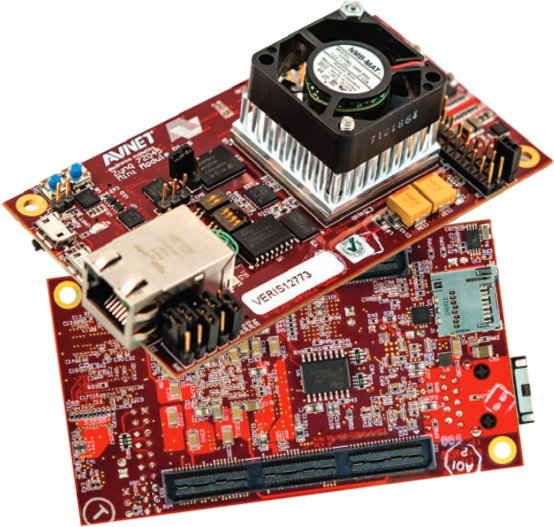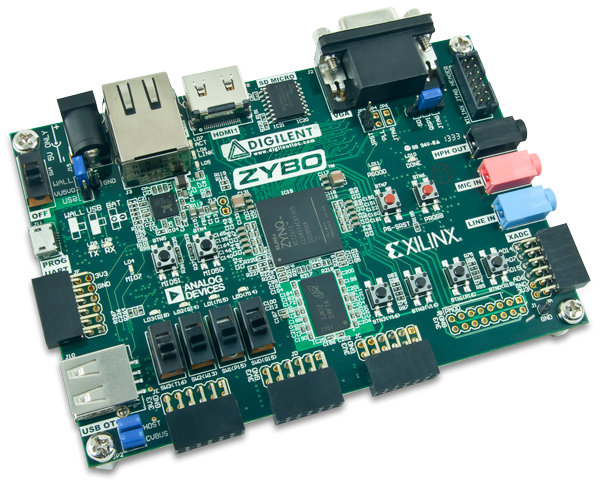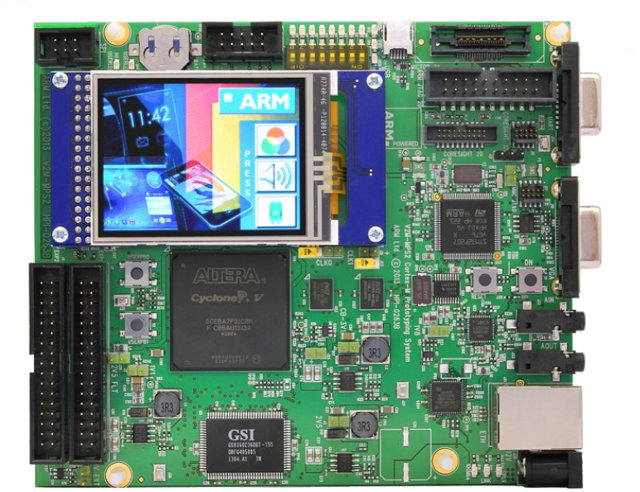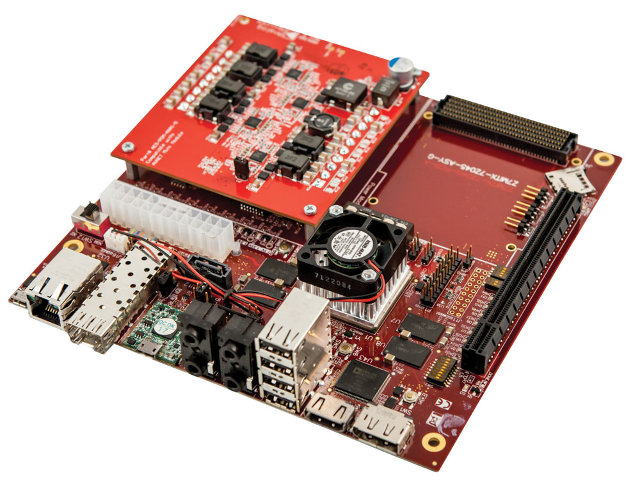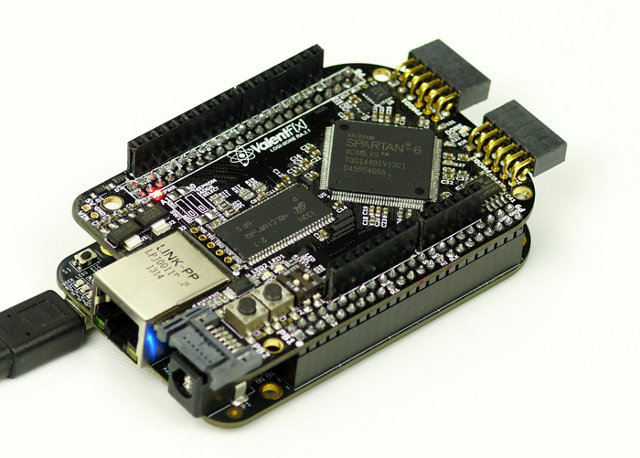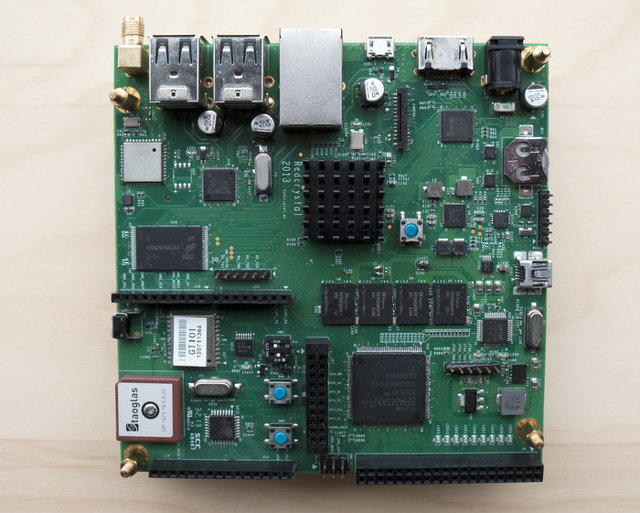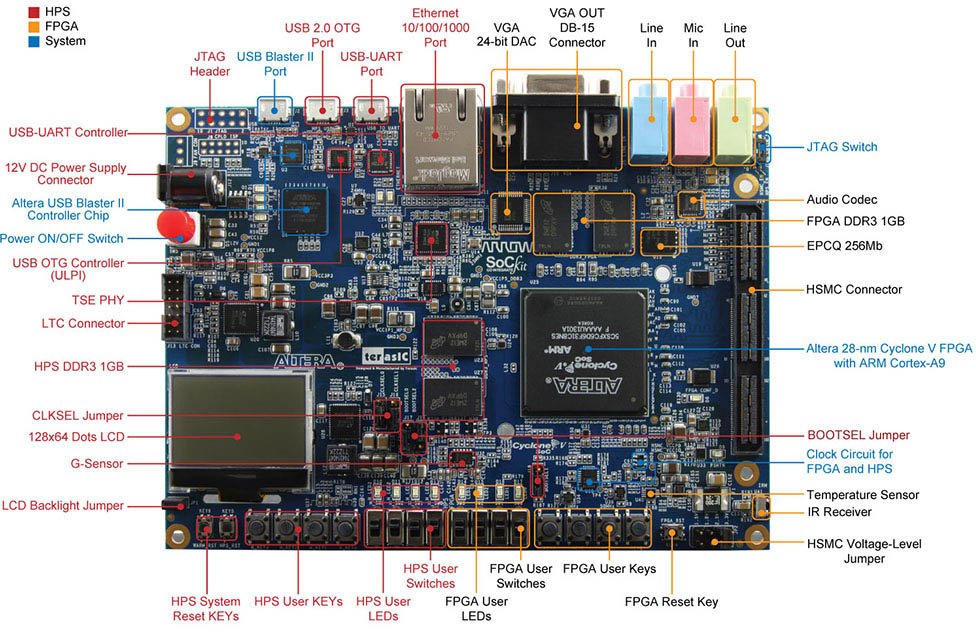In January 2014, Avnet announced Xilinx Zynq-7000 All Programmable SoC Mini-ITX board featuring Xilinx Zynq-7045 or Zynq-7100 ARM + FPGA SoC, and more recently, the company has launched “Xilinx Zynq-7000 All Programmable SoC Mini-Module Plus” systems-on-module (SoM) based on the same platforms, as well as a corresponding development kit including a baseboard and a power module. The SoM and development platform target PCI Express, embedded controllers, general-purpose prototyping, networking and communications, storage and servers, and Ethernet/Internet applications. Xilinx Zynq-7000 Mini-Module Plus specifications: SoC- Xilinx Zynq-7045 or Zynq-7100 dual core Cortex-A9 @ up to 1GHz with FPGA (350K or 444K logic cells) System Memory – 1GB DDR3 SDRAM Storage – 128MB parallel flash, 32MB QSPI flash, 8KB EEPROM, and micro SD slot Connectivity – Gigabit Ethernet USB – USB 2.0 OTG port Debugging – USB UART, JTAG programming/configuration port, PJTAG header User’s IO via dual board-to-board connectors: 132 User I/O (66 […]
ZYBO Development Board Features Xilinx Zynq-7010 FPGA + ARM SoC, VGA and HDMI Output
Digilent ZYBO (ZYnq BOard) is a low cost development board powered by Xilinq Zynq-7010 SoC featuring a dual core ARM Cortex A9 processor and FPGA fabric. It’s using the same SoC as MicroZed, is in the same price range as it costs $189 ($125 for academic purpose), but adds video interfaces, namely bi-directional HDMI and VGA, that are not available in MicroZed. It does come however with less RAM (512 MB vs 1GB). Digilent ZYBO specifications: SoC – Xilinx ZYNQ XC7Z010-1CLG400C dual core Cortex A9 processor + FPGA with 28K Logic Cells (~430K ASIC gates). System Memory – 512MB x32 DDR3 w/ 1050Mbps bandwidth Storage – 128Mb Serial Flash w/ QSPI interface, MicroSD slot for Linux file system, EEPROM programmed with 48-bit globally unique EUI-48/64™ compatible identifier. Video I/O – Dual-role (Source/Sink) HDMI port, 16-bits per pixel VGA output port Audio I/O – Audio codec with headphone out, microphone and […]
ARM Unveils Cortex-M Prototyping System Based on Altera Cyclone V FPGA
Before micro-controllers or processors are manufactured, simulation is performed in (usually) expensive boards based on FPGA chips from Altera or Xilinx, and once designers have found the system to work as expected, they can move to the next phase and work on the actual silicon. ARM has just released V2M-MPS2 Cortex-M Prototyping System for MCU / SoC / ASIC designers working on Cortex-M processors. Key features: Altera Cyclone V FPGA with ~150K LE 4x 2MB ZBTRAM (32-bit each, with two of them forming a 64-bit memory). ZBT = Zero Bus Latency 16MB PSRAM (16-bit) Touch screen LCD module Range of hardware interfaces – UART, VGA (4 bit per color), SPI, audio (I2S), Ethernet, LEDs, buttons I/O expansion ports (GPIO) FPGA images for Cortex-M processors Example project for Cortex-M0 DesignStart (processor IP has to be licensed separately) USB connection for downloading FPGA images and program image to micro SD card on board […]
Xilinx Zynq-7000 All Programmable SoC Mini-ITX Development Board
Avnet has recently introduced Xilinx Zynq-7000 All Programmable SoC Mini-ITX Development Board powered by the top of the range Xilinx Zynq-7045 or Zynq-7100 dual ARM Cortex A9 + FPGA SoC with 2 GB DDR3 SDRAM, PCIe Gen2 x16 Root Complex slot (x4 electrical), SATA-III interface, 10/100/1000 Ethernet PHY, and more. Target applications include PCI Express, embedded controllers, general-purpose prototyping, networking and communications, storage and servers and video applications. Here are the motherboard specifications: SoC – Xilinx XC7Z045/XC7Z100-2FFG900 dual core ARM Cortex A9 @ 800 MHz + Kintex-7 FPGA with respectively 350K Logic Cells (~5.2M gates) and 444K Logic Cells (~6.6M gates). System Memory – 1 GB PS DDR3 SDRAM, 1 GB PL DDR3 SDRAM Storage – 32 MB of QSPI Flash, 8 KB of I2C EEPROM, SATA-III Interface, and microSD Card Interface Real-Time Clock Connectivity – 10/100/1000 Ethernet Interface Video – LVDS Touch Panel Interface, HDMI Interface Audio – Audio input […]
$89 LOGi Development Boards Add FPGA and Arduino Headers to the Raspberry Pi and Beaglebone Black (Crowdfunding)
LOGi-Pi and LOGi-Bone are expansion boards featuring Xilinx Spartan 6 for respectively the Raspberry Pi, and the Beaglebone Black. Valent F(x), the company who designed the boards, is currently looking for funds via Kickstarter in order to bring the cost down to $89, or even $69 for early backers. LOGi boards specifications: FPGA – Xilinx Spartan 6 LX9 TQFP-144 FPGA 9,152 Logic Cells, 16 DSP48A1 Slices, 576KB Ram, and 96 User Available I/O Pins System Memory – 256 Mb SDRAM connected to the FPGA Storage – 1x High Bandwidth SATA connector expansion port Video Output – 10x Length-tuned LVDS Pairs Connectors: 2x Digilent Inc. PMOD ports supporting 59+ plug-and-play hardware modules Arduino compatible headers connected to the FPGA pins (3.3v only) supporting over 200 Arduino Shields. Bit-Stream loading interface connected to the host processor, optional bitstream FPGA self-loading from onboard Flash. Misc – 2x LEDs 2x Push Buttons 2x DIP Switches 3.3v I/O Regulator and […]
Crystal Board Combines Rockchip RK3188 ARM SoC with Xilinx FPGA and Arduino Compatible Board (Crowdfunding)
Red Crystal, a German startup, has just introduced the Crystal Board, a 3-in-1 development board with Rockchip RK3188 SoC running Linux or Android, an Arduino UNO compatible board, and a Xilinx Spartan-6 FPGA. The concept is a similar to the UDOO board, but adds an FPGA. The company has launched a Kickstarter campaign to gather funds to manufacture the Lite and Pro versions of the board for respectively $149 and $179. Crystal Board specifications (Lite and Pro versions): SoC – Rockchip RK3188 ARM Cortex-A9 quad core up to 1.8Ghz + Mali-400 MP4 GPU MCU – Atmel Atmega328 SMD FPGA – Xilinx Spartan6 XC6SLX9 with 9152 logic cells System Memory – 2GB DDR3 @ 1066MHz (1GB DDR3 @ 1066MHz for Lite version) Storage – micro SD card slot, SPI flash Video Output – HDMI 1.4 Connectivity: 10/100M Ethernet port Wi-Fi 802.11b/g/n with antenna. Dual band for Pro version, 2.4GHz band for […]
Terasic’s Altera DE1-SoC Board Based on Cyclone V Dual Cortex A9 + FPGA SoC Sells for $150 Up
A few months ago, Terasic unveiled its SoCKit powered by Altera Cyclone V dual Cortex A9 + FPGA. They’ve now announced a cheaper version will a less powerful Cyclone V SoC and lower specs (e.g. less RAM, only one sensor, etc…) that sells for as low as $150 for educational or academic purposes, and $199 for the rest of us. Altera DE1-SoC Board specifications: FPGA Device Cyclone V SoC 5CSEMA5F31 Device Dual-core ARM Cortex-A9 (HPS – Hard Processor System) 85K Programmable Logic Elements 4,450 Kbits embedded memory 6 Fractional PLLs 2 Hard Memory Controllers Configuration and Debug Quad Serial Configuration device – EPCQ256 on FPGA (EPCQ = Erasable Programmable Configurable Quad-SPI device) On-Board USB Blaster II (Normal type B USB connector) Memory Device 64MB (32Mx16) SDRAM on FPGA 1GB (2x256Mx16) DDR3 SDRAM on HPS 128MB QSPI Flash on HPS (QSPI Flash does not come pre-installed out of factory) Micro SD […]
$249 Terasic SoCKit Development Kit Features Altera Cyclone V SX Dual Core A9 + FPGA SoC
There seems to be a lot a development going on around dual core A9 + FPGA SoCs from Xilinx or Altera these days, and Terasic has recently announced SoCKit, a development board based on Altera Cyclone V SX SoC with 2GB RAM (1GB for ARM cores, 1GB for FPGA), 110K logic elements, etc… Here are the specifications listed on Terasic website: FPGA Device – Cyclone V SX SoC—5CSXFC6D6F31C8NES: 110K LEs, 41509 ALMs 5140 M10K memory blocks 6 FPGA PLLs and 3 HPS PLLs 2 Hard Memory Controllers 3.125G Transceivers ARM-based hard processor system (HPS) @ 800 MHz, Dual-Core ARM Cortex-A9 MPCore Processor with 512 KB of shared L2 cache, 64 KB of scratch RAM, Multiport SDRAM controller (DDR2, DDR3, LPDDR1, and LPDDR2), and 8-channel direct memory access (DMA) controller Configuration and Debug: Quad Serial Configuration device – EPCQ256 for FPGA On-Board USB Blaster II (micro USB type B connector) Memory […]


